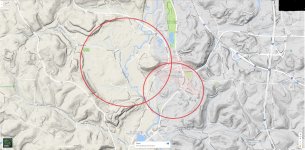I was doing some glacial research and came across this location. It looks like a nice size meteorite split into two and landed just over a mile apart (1.25 miles). I find it hard to believe that this is erosion from drainage or glacial advance. This area is just on the edge of where the wisconson glacier stopped. So, most hard evidence would be buried under tens of feet of sediment at the LEAST.
The larger crater is about a mile and a half in diameter, and the smaller crater is about 1 mile in diameter.
Here is the location on g earth 40.8343974,-80.4154834
https://www.google.com/maps/place/4...x0!7e2!8m2!3d40.8341973!4d-80.4110494!5m1!1e4
There are 2 central uplifts in each of the craters; however, the larger crater's 'center' uplift insn't on center. Could this be because there was a second collision with the earth so the uplift was somewhat averaged between the 2 shocks? Or perhaps the angle the meteorite came down was pretty great so the uplift wld b further back from center? It seems as if one side is built up larger and the other smaller/eroded away to support the angle hypothesis.
IDK maybe I'm crazy, tell me what you guys think! If you can't find it just type in new galilee, pa into google earth and turn on the terrain feature!

The larger crater is about a mile and a half in diameter, and the smaller crater is about 1 mile in diameter.
Here is the location on g earth 40.8343974,-80.4154834
https://www.google.com/maps/place/4...x0!7e2!8m2!3d40.8341973!4d-80.4110494!5m1!1e4
There are 2 central uplifts in each of the craters; however, the larger crater's 'center' uplift insn't on center. Could this be because there was a second collision with the earth so the uplift was somewhat averaged between the 2 shocks? Or perhaps the angle the meteorite came down was pretty great so the uplift wld b further back from center? It seems as if one side is built up larger and the other smaller/eroded away to support the angle hypothesis.
IDK maybe I'm crazy, tell me what you guys think! If you can't find it just type in new galilee, pa into google earth and turn on the terrain feature!










